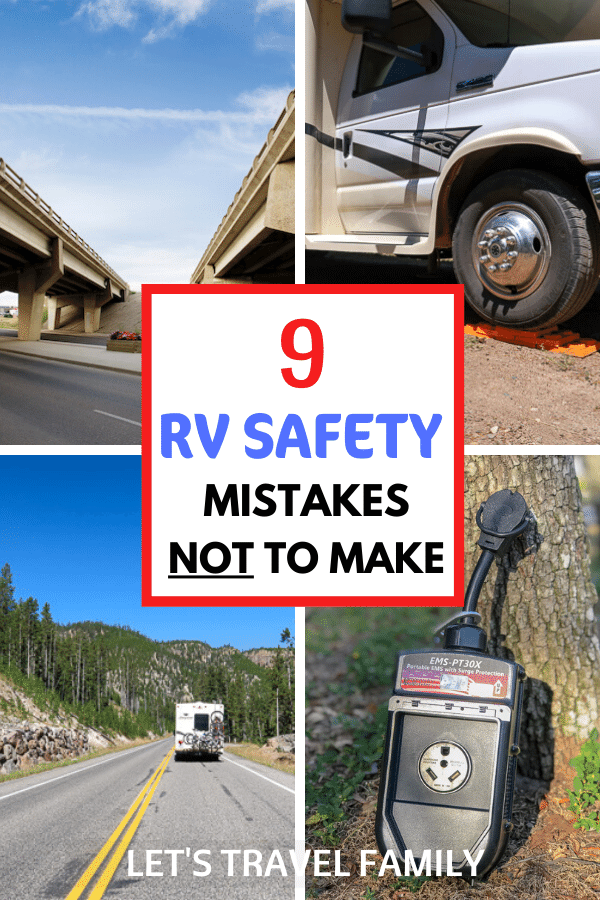RVing can be a bit overwhelming, more so if you’re just getting started. Safety is a major concern for many new RV owners, and I wanted to dive into some helpful RV safety tips so that you don’t make the same mistakes we’ve made.
Take RV safety seriously from the beginning. You won’t regret it.
Learn from our RV living family and be sure to read all RV safety 9 RV safety mistakes NOT to make on your RV journey.
RV Safety Mistakes NOT To Make
1. Leaving things on the floor
One time we left our cast iron skillet on the floor and it was a disaster!
You see, anything that’s not connected to the wall, kept in a closed container or cabinet, or screwed to the floor has a high risk of being moved around when you’re driving your RV.
We were lucky it was a cast-iron skillet and not something that breaks easily because that’s even more dangerous!
Remember to check if there’s no remaining stuff that’s not secure before driving away to your next destination.
2. Did not check bridge heights
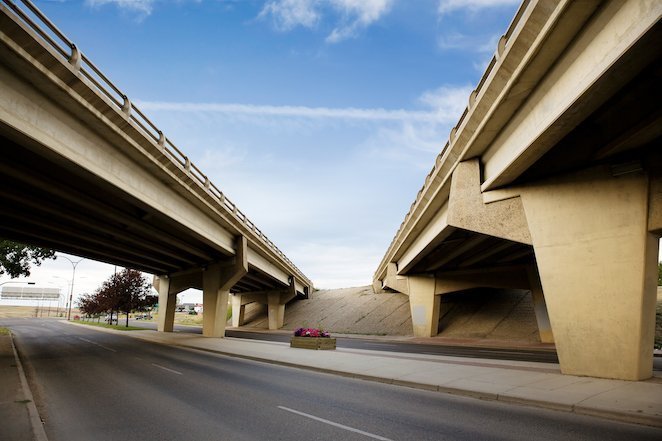
Once, we forgot to look at bridge heights before driving our RV!
Sometimes we get so into the driving that we forget about important things, like checking the bridge height of any roads we plan to drive on. And that can be a cause for disaster.
An RV is like a tiny home, but it’s bigger and certainly heavier if you compare it to other vehicles. That’s why we have to be extra careful when driving it around.
Some RVs tower even over other RVs and the height of bridges are NOT standard so if you have a feeling that your RV won’t fit, it is best to check it.
Pro tip: keep a post-it note on your dashboard with the height of your RV so you always know as you’re coming up to signs with height warnings. This will stop you from wondering if you remembered your height correctly or not.
3. Refrigerator door left open
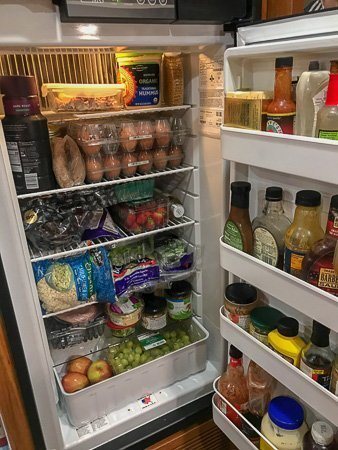
You really have to double-check everything before moving along or you’ll end up with a refrigerator door left open like us! This is a common mistake for cupboards and closets too as they usually make a loud ‘click’ when they shut all the way.
Latch your refrigerator tight before traveling!
It gets worse if the food you’re keeping flies out of the fridge. Oh, and having the door left open kind of defeats the purpose of having the refrigerator because the food will not keep well if it’s exposed like that.
So check that the refrigerator door CLICKS SHUT and all of the contents if they are packed safely!
4. Not disconnecting hookups
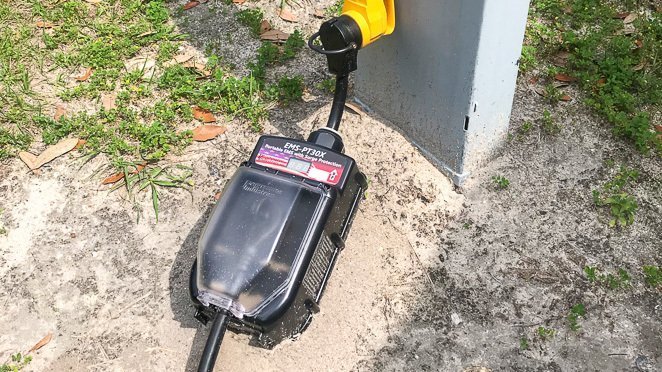
Unless you want to drive around with what looks like tentacles at the back of your RV, disconnect all hookups after your stay in an RV park before driving.
This has happened to a lot of RVers and the pictures are always hilarious. But if you’re the one with the hookups dangling like that, it will be extremely embarrassing!
Plus it can damage the campsite pedestal that you left and your own hookups, too. Flailing around like that also makes it a hazard for those around your RV.
Learn exactly how to become a master at keeping your RV organized and looking great without feeling overwhelmed when you grab a copy of our 73-page ebook. Click here to grab a copy of Organize Your RV Like A Pro.
5. Driving fast on sharp curves
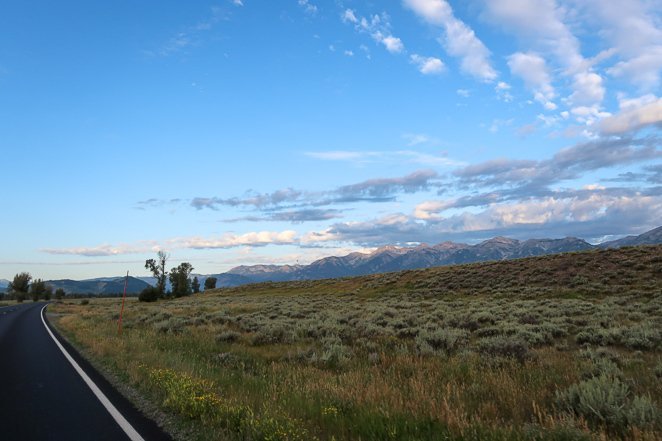
RVs are heavy, you cannot do sharp curves fast or you will risk everyone’s safety!
Honestly, we recommend driving 10 mph below the speed limit when towing or driving a motorhome. Plan in enough time and take it easy.
Remember, it is better to drive slowly and be sure that everyone is safe than drive so fast to get to your destination quickly all the while risking everyone’s safety.
6. Not leveling your RV
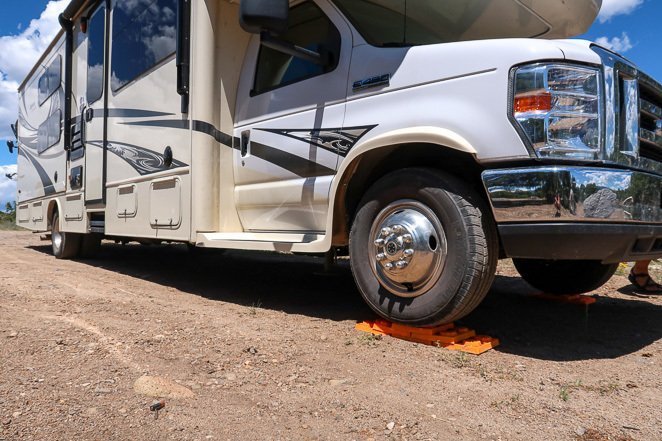
Remember that one funny scene in a movie where a car is going straight down a slope? Yeah, that happens in real life. That’s why leveling is so important.
When you are setting up camp, it might be helpful to follow an RV set-up checklist to make sure you’ve covered all your steps.
Not every campsite or parking space you find is as flat as you want it to be. You still have to make adjustments like leveling to make sure that your stay inside the RV is stable and comfortable.
You can use different types of levels for your RV as long as it works. Also, remember to put leveling blocks under the tires that need raising and emergency breaks should be on.
If you want to know more about which leveling block is the best for your RV, check out our Best RV Leveling Blocks blog post!
7. Unknown Fuel Capacity
There are many times that you’ll have to drive through a very remote area of the country to get to your destination. And there are times when you might chance running out of gas. When these two happen at the same time, that’s a problem.
That’s why we should know the range of the RV we’re driving. If we don’t, we won’t know how to monitor it or know when it will run out!
This way, you’ll also know how much extra gas you should have or if you need to fill up soon even if you’re not low on fuel yet.
Pro tip: download some of these apps to help you plan out your travel day and know your route.
8. Awning left down
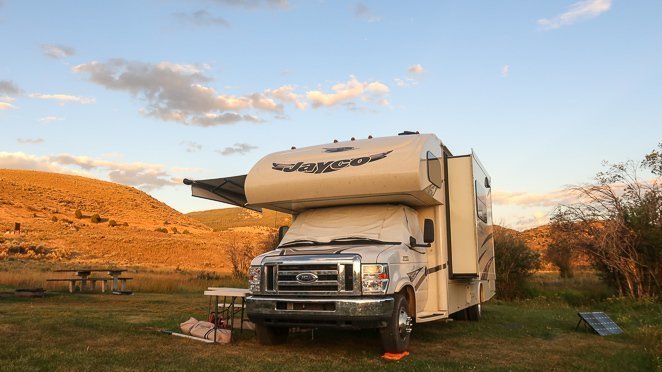
This is almost the same as leaving your hookups on, only, this one is on top of the RV.
Always remember to bring in your awning before you travel!
I don’t know what’s worse, having tears and scratches on it or having it stuck on a tree branch (which may take hours of fixing or completely destroying it).
9. Letting it get too humid in your RV (mold alert!)
A safety mistake that many new RV owners make is not considering the humidity levels inside your RV when you’re camping near the coast.
Mold can cause a lot of damage to your RV and is so unhealthy to be around. That’s why I recommend you buy the best dehumidifier for RV camping and run it daily while in humid climates. In addition, you can also open your windows for a few minutes each day to help get fresh air inside and moving around.
10. Forgetting to check the tires
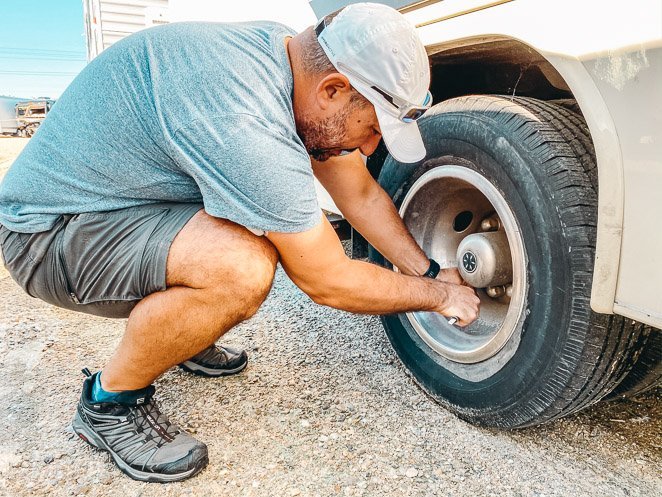
Lastly, the matter that gets forgotten even by many people driving cars is forgetting to check the tires. Yet, it’s even more critical with an RV due to its weight and risk of a blowout.
This is something that you should do every trip. A road trip is not fun if you suddenly have to stop because of a flat tire. Not only will it take time and stress to fix it, but it could do damage to your RV or even cause an accident. This is the reason why tire inflators and tire gauges are essentials in an RVer’s toolkit.
Some small mistakes or things that you forgot to look over can break the perfect mood for your trip so remember to check EVERYTHING.
A few minutes of going around inside and outside the RV is nothing in comparison to hours of fixing a flat tire or an awning that’s stuck somewhere, not to mention the costs.
You also don’t want an accident that can hurt you or the people around your RV just because you forgot to check something.
Everyone makes mistakes but we hope we can help you commit less of those with this list.
Related posts:
Top RV Campsites To Check Out
Tips for RV Road Trips
Full Time RV Living Tips
